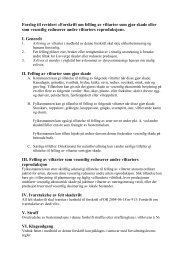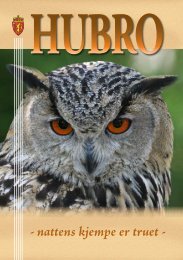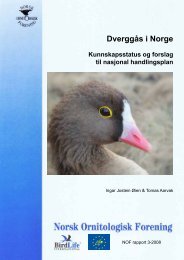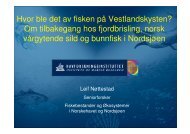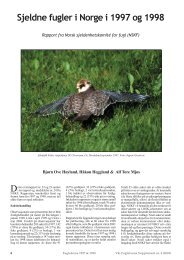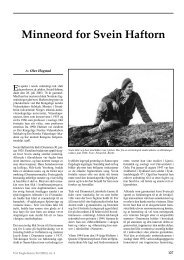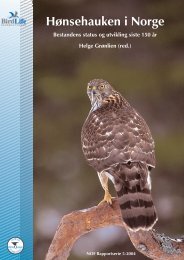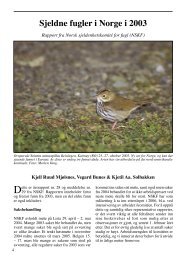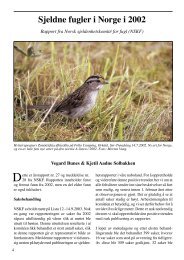Fennoscandian Lesser White-fronted Goose conservation project ...
Fennoscandian Lesser White-fronted Goose conservation project ...
Fennoscandian Lesser White-fronted Goose conservation project ...
You also want an ePaper? Increase the reach of your titles
YUMPU automatically turns print PDFs into web optimized ePapers that Google loves.
<strong>Fennoscandian</strong> <strong>Lesser</strong> <strong>White</strong>-<strong>fronted</strong> <strong>Goose</strong> <strong>conservation</strong> <strong>project</strong> – Annual report 1999<br />
Tolvanen et al: Monitoring the autumn staging of <strong>Lesser</strong> <strong>White</strong>-<strong>fronted</strong> Geese in Kazakstan, October 1999<br />
Table 2. Total numbers (counts) of geese in the surveyed roosting lakes in the Kustanay region, proportions of the four most numerous goose<br />
species based on random sample data, and respective estimates of number of individuals. For the lakes Batpakkol, Kulakol, Kushmurun,<br />
Bozshakol, Sarykol and for other places where no sample data was obtained and no rough estimate of species proportion was made in the<br />
field, a weighted mean of the proportion of these species at the sampled lakes was applied (marked with * in the table). The estimates for each<br />
species were achieved by using these weighted mean proportions. Because of the clear difference in the species proportions between the<br />
southern and northern parts of the area, the species proportions were calculated separately in the southern and northern parts. The weighted<br />
mean of the southern lakes Kulykol and Ayke was applied for Lake Batpakkol, and the weighted mean of the northern lakes Koybagar and<br />
Tyuntyugur was applied for the lakes Bozshakol and Sarykol and for other places. The numbers of individuals in bold (counts for the lakes<br />
Kulakol and Tali) are not estimates but direct counts, and for these two lakes the percentages of each species are calculated directly from<br />
these counts. For the sampled lakes, the 95% confidence intervals for species proportion estimates and for the corresponding estimates of the<br />
number of individuals are given below the estimates.<br />
Lake Total no. no. ind. Anser albifrons Anser anser Anser erythropus Branta ruficollis<br />
of geese sampled % estimate % estimate % estimate % estimate<br />
Kulykol 86,000 10,950 65.91 56,700 8.44 7,260 2.15 1,850 23.50 20,200<br />
95% c.i.: 65.02–66.80 55,900–57,400 7.92–8.96 6,810–7,710 1.88–2.42 1,620–2,080 22.71–24.29 19,500–20,900<br />
Ayke 60,000 3,210 78.04 46,800 9.78 5,870 2.09 1,250 10.10 6,060<br />
95% c.i.: 76.61–79.47 46,000–47,700 8.75–10.81 5,250–6,490 1.60–2.58 960–1,550 9.06–11.14 5,440–6,690<br />
Batpakkol 30,000 *0 *82.1 *24,600 *10.4 *3,120 *2.5 *740 *5.0 1500<br />
Kulakol 550036.36 200 54.55 300 0 0 9.09 50<br />
Kushmurun 1,500 *0 *1,040 *120 *1 *360<br />
Koybagar 33,000 3,000 55.67 18,400 10.93 3,610 0.07 22 33.33 11,000<br />
95% c.i.: 53.89–57.45 17,800–19,000 9.81–12.05 3,240–3,980 0–0.16 0–54 31.64–35.02 10,400–11,600<br />
Tyuntyugur 25,000 3,240 84.81 21,200 3.83 960 0.06 15 11.30 2,820<br />
95% c.i.: 83.57–86.05 20,900–21,500 3.17–4.49 790–1,120 0–0.14 0–36 10.21–12.39 2,550–3,100<br />
Bozshakol 8,000 *0 *68.2 *5,460 *7.9 *630 *0.06 *5 *23.8 1,900<br />
Sarykol 400 *0 *68.2 *270 *7.9 *32 *0.06 *0 *23.8 *95<br />
Tali 1,100 0 77.27 850 18.18 200 0 0 4.55 50<br />
Other places 1,000 *0 *68.2 *680 *7.9 *79 *0.06 *1 *23.8 *240<br />
Total 246,550 20,400 176,200 22,200 3,880 44,300<br />
individuals in the sample material (0.02% of the total) – altogether 9<br />
Bean Geese were observed, 3 of them identified as rossicus-type<br />
and 3 of fabalis-type. Two Brent Geese of the nominate race bernicla<br />
were seen (one at Lake Kubikol 6 October, and one at Lake Sholak<br />
13 October) – the latter of these happened to be included in a random<br />
sample.<br />
The total sample size for the age ratio of <strong>White</strong>-<strong>fronted</strong> <strong>Goose</strong><br />
was 13,680 individuals (456 samples of 30 individuals), i.e. 3.16%<br />
of the estimated total number of <strong>White</strong>-<strong>fronted</strong> Geese. This sample<br />
data resulted in a proportion of 53.3% juvenile (1st-calendar year)<br />
birds (95 % confidence interval for juv% = 52.46–54.14). Due to the<br />
relatively low number of LWfG, the age ratio (or brood size) of LWfG<br />
could not be sampled in a similar way. In the species sample data,<br />
16 out of the 62 LWfG identified by age were 1st-calendar year birds,<br />
which yields a juvenile proportion of 26 %.<br />
3.3. Pooled results<br />
Altogether, c. 747,000 geese were counted contemporaneously in<br />
the two survey areas. Of these, c. 4,850 ind. (0.65%) were estimated<br />
to be LWfG, c. 52,900 ind. (7.1 %) Red-breasted Geese, c. 54,300<br />
ind. (7.3%) Greylags, and the majority, c. 635,200 ind. (85 %) were<br />
<strong>White</strong>-<strong>fronted</strong> Geese. The proportion of LWfG was considerably<br />
higher in the Kustanay region (1.6% of all geese), as compared with<br />
the Kurgaldzhino–Tengiz region (0.19%). The same applies for Redbreasted<br />
<strong>Goose</strong> (18.0% in the Kustanay region versus 1.7% in the<br />
Kurgaldzhino–Tengiz region). Data on the the brood size of LWfG<br />
is presented in Table 4.<br />
4. Discussion<br />
The results of the surveys ascertain the importance of the Kustanay<br />
region as the main autumn staging area for the western populations<br />
of LWfG and for the entire world population of Red-breasted <strong>Goose</strong>:<br />
the proportion and the estimate of the number of individuals for these<br />
two species were considerably higher in the Kustanay region as<br />
compared with the Kurgaldzhino–Tengiz region. However, much<br />
higher numbers of <strong>White</strong>-<strong>fronted</strong> Geese were counted in the<br />
Kurgaldzhino-Tengiz region. In the Kustanay region, the most<br />
important staging areas for LWfG are clearly located in the southwestern<br />
part, with Lake Kulykol being the most important. In the<br />
Kurgaldzhino–Tengiz region, the lakes Korzhynkol (Baumanskoye),<br />
Shunkyrkol and Sholak hosted the highest proportions of LWfG,<br />
46<br />
Table 4. The brood size data of <strong>Lesser</strong> <strong>White</strong>-<strong>fronted</strong> <strong>Goose</strong> in different<br />
regions.<br />
Kustanay Kurgaldzhino-Tengiz Total<br />
Brood type 1 ad 2 ad 1 ad 2 ad<br />
1 juv. – 1 2 2 5<br />
2 juv. – 3 2 1 6<br />
3 juv. – 2 – – 2<br />
4 juv. – 1 – 4 5<br />
5 juv. – 1 – – 1<br />
6 juv. – 2 – 1 3<br />
Total – 10 4 8 22<br />
mean juv. / brood 3.4 2.7 2.8<br />
mean ad. / brood 2.0 1.7 1.8<br />
although Lake Kubikol hosted the highest number of geese in total.<br />
In the previous surveys in the Kustanay region in 1996 and 1998,<br />
numbers equalling c. 50% and up to more than 90% (Table 5) of the<br />
western population of LWfG (c. 8,500-17,000 ind. according to<br />
Lorentsen et. al. 1999) and up to 100% of the world population of<br />
Red-breasted <strong>Goose</strong> (70,000 ind. according to Hunter et al. 1999)<br />
have been estimated staging in the area in autumns 1996 and 1998<br />
(Tolvanen & Pynnönen 1998, Tolvanen et. al 1999b). The lower total<br />
number of geese in Kustanay in 1999 region as compared with the<br />
years 1996 and 1998 (Table 5) might be a result of differences in<br />
timing of the migration of LWfG and Red-breasted <strong>Goose</strong> due to<br />
unusual warm weather in autumn 1999; possibly some part of the<br />
geese could still be staying in the more northern staging areas during<br />
the first half of October. However, in the Kurgaldzhino-Tengiz region,<br />
where G. Eichhorn continued the waterbird censuses until the<br />
beginning of November, the peak number of geese was observed<br />
during the LWfG survey (2–13 October), which does not support<br />
the assumption of late timing of the goose migration.<br />
4.1. Kustanay region<br />
In the Kustanay region, the total number of geese was somewhat<br />
less than during previous surveys. This difference is mainly due to a<br />
lower number of geese at Lake Kulykol, where remarkable<br />
concentrations were observed during the previous surveys: 120,000<br />
ind. in October 1996 (Tolvanen & Pynnönen 1998) and 160,000 ind.<br />
in October 1998 (Tolvanen et. al 1999b). In the lakes visited both<br />
during the 1998 and 1999 surveys, considerably more birds were<br />
seen in 1999 at the lakes Batpakkol and Koybagar, while the figures



